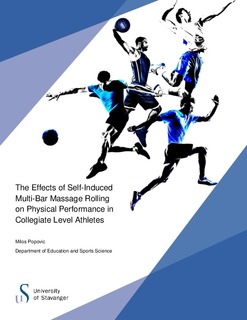| dc.description.abstract | Purpose: The purpose of this study was to examine the effects of 5-, 10-, and 15-minute massage with a mechanical self-induced multi-bar massage roller on balance, anaerobic power, and anaerobic and aerobic capacity. Methods: Thirteen (volleyball, n = 7; basketball, n = 2; lacrosse, n = 2; handball, n = 1; strength training, n = 1) male collegiate level athletes (mean ± SD; age = 25.15 ± 5.6 years; height = 1.84 ± 0.7 m; body mass = 82.4 ± 9 kg) completed the study. The treatment consisted of massage-rolling 4 different muscle groups in the following order: 1) gastrocnemius, 2) hamstrings, 3) quadriceps, and 4) gluteus maximus. Total massage time was split equally between the 4 muscle groups. Participants completed 4 testing sessions (1 control condition and 3 experimental conditions). During experimental conditions participants received the treatment before proceeding to testing. Each testing session participants completed a static single-leg balance test, followed by a standardized warm-up, then a squat jump test, a countermovement jump test, Bosco’s 30-second jump test, and a 20 m shuttle-run test. Results: None of the differences were statistically significant (p > 0.05). Results indicated that the effects were not massage length dependent. Trivial to large (d = 0.1 – 0.8) effects were observed for the static single-leg balance test after the massage protocols. For the squat jump test, an overall trivial (d ≥ -0.09) effect was observed after the massage protocols. For Bosco’s 30-second jump test, adverse results were observed after the massage protocols, with moderate to trivial (d ≥ -0.6 – d = ≤ 0.2) negative and positive effects. Overall trivial (d ≤ 0.1) effects were observed for the 20 m shuttle-run test after the massage protocols. The magnitude-based inference analysis indicated the effects of the massage protocols were unclear for most physical performance parameters. For sway velocity on left foot, 5-, 10-, and 15-minute massage protocols were shown to be likely beneficial (88.8%, 90%, and 86.4%, respectively). The 5-minute massage protocol was shown to be 76.5% unlikely beneficial for the number of vertical jumps at 15 seconds, while the 10-minute massage protocol was shown to be 56.8% unlikely beneficial for heart rate during Bosco’s 30-second jump test. Conclusion: Five, 10, and 15 minutes of self-induced multi-bar massage rolling may have some positive effects on balance performance, but does not appear to affect anaerobic power and anaerobic and aerobic capacity in any way that would have an impact on athletic performance. | nb_NO |

